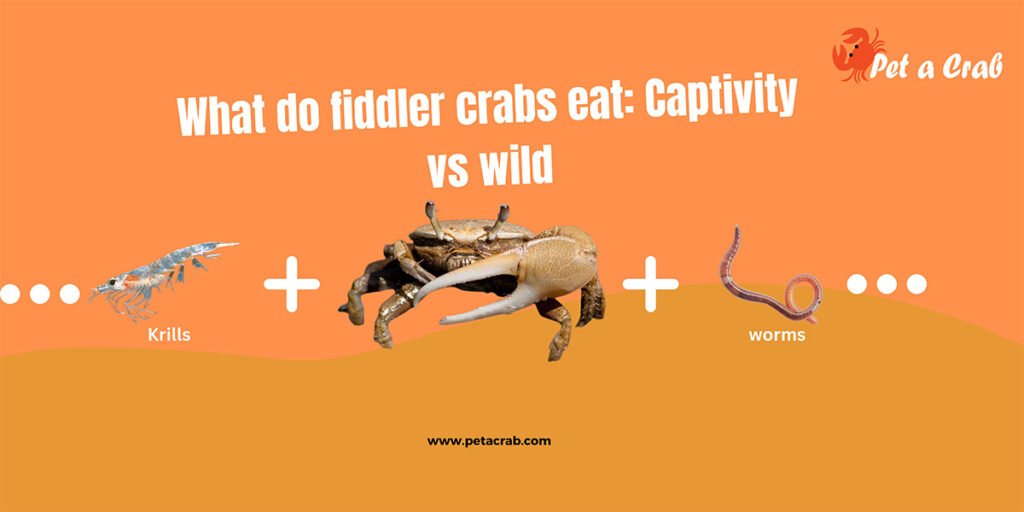The orange-arm borneo crab has a beautiful yellow to orange armed appearance, which makes it a great pet for crabists. Only a few years ago in 2015, it was discovered. That’s why there is no information regarding this species though it is not new in the pet industry.

Being a freshwater paludarium crab, this crab is very easy to care for. Throughout this article, I’ll discuss its care and everything you need to know.
There is no clear information about the species of orange arm borneo crab or exactly which species it belongs to; through my research, I found it is Lepidothelphusa loi which is endemic to Malaysia.
Quick overview of orange arm borneo crab
| Names | Orange arm borneo crab, orange arm ninja crab |
| Scientific name | Lepidothelphusa loi |
| Care level | Easy |
| Diet | Omnivore |
| Sleeping nature | Nocturnal |
| Size | Up to 4 cm |
| Color | Brown, orange |
| Optimal temperature | 24-30°C |
| Breeding | Possible |
| Temperament | Peaceful |
Habitat and distribution
They can be found in rocky forest areas, near streams, and rivers that are endemic to Sarawak, Malaysia, Borneo. The crab is semi terrestrial - which means it spends most of its time on land near water sources and often submerges in freshwater.
Appearance
The orange arm borneo crab has a square-shaped, smooth carapace and a yellowish-red body, reddish-brown legs, and yellowish claws. 1
The males have a different sized claw, one bigger than the other; the bigger claw is covered with hairs, while the females have same sized claws.
The crab has been named after Michael Lo for his help in finding these crabs.

Caring for orange arm borneo crab
Tank setup
Size
They will need a lot of space to crawl around and thrive. Choose a minimum of a 15 gallon tank for two crabs. 20 - 25 gallons for a small group (5 - 6). If you plan to keep them with other animals, increase the size accordingly, ensuring the tank doesn’t get crowded.
They are known for great climbing, so don’t forget to cover the tank with a lid or else they may escape.

Substrate
Prefer soil substrate over sand, as it mimics their natural habitat. You can use a mix of 20% sand and 80% soil but only sand is not preferable as it is a freshwater crab. A rule of thumb is that sand substrate is ideal for saltwater or brackish crabs and for freshwater crabs soil substrate is ideal.
In the wild, they live on a substrate composed of moist mud and sand with leaf litter.
Orange arm borneo crabs will need a freshwater paludarium or vivarium. There should be a section for water of approximately twenty percent and the other eighty percent will be land.
The water should be deep enough so that the crab can submerge itself fully and easily get out of the water. Also, the substrate should be 4-5 inches deep, as the crab will burrow and hide. Use some gravel with substrate, ensuring small grains.

Decoration
Spread some medium-sized stones over the substrate and create 1 - 2 hideouts; a minimum of one cave for one crab. Use some woods like spider wood, cholla wood and half log pipe; there are many options you can choose from on Amazon.
Use paludarium plants, ferns and mosses to make it more natural, which will keep the environment humid.
Temperature and humidity
The temperature range should be between 24 and 30°C. It is important to keep the temperature constant; too much fluctuation in it can cause serious health issues. You can use a heating pad to warm up the temperature and a thermometer to keep track of it.
Orange arm borneo crab will need high humidity, which is 80 to 100 percent. A normal humidity level for any crustacean would be below 80 percent. So the humidity is above average—if the enclosure normally can’t reach 80%, you should regularly mist it or use a humidifier; a hygrometer will be necessary to keep track of that.
Keep the pH between 7.5 and 8.0 with a KH of 4 and 10
What to feed them
Offer the crustacean pellets, fish pellets or flakes. Offer meat sources such as brine shrimp, bloodworms, frozen meaty food, and crickets. Orange arm borneo crabs will happily accept any kind of vegetable or fruit.
Give boiled vegetables, such as spinach and cucumber. They’ll love this and it helps with digestion.
In the wild, they depend on algae, detritus, decaying leafy/plant matter, and animal matter. So they will also help clean the tank.
Molting
Orange arm borneo crabs will go through molting every 1-2 months. In the molting period, they become much weaker and show less activity. For example, they can eat more and hide more than usual; don’t stress them by handling them aggressively.
If there are tankmates that tease the molting crab, you better keep it in isolation for a while and give it calcium rich foods such as cuttlebone, broccoli, kale and spinach, which help them grow a strong exoskeleton and recover from molting quickly.

Tank mates for orange arm borneo crab
This crab is peaceful with its own species; however, it competes with geosesarma species in the wild.
Same sized crabs, like purple crabs and blue spider crabs, can be kept together. But the paludarium has to be bigger so that no territorial dispute happens. However, skipping crabs is preferable as most of the crabs are aggressive.
Also, in your set, you can consider dart frogs and dwarf geckos. For the water part, you can consider freshwater, small, non aggressive fish such as neon tetras, rasboras, guppies and cherry barbs.


